- Author Curtis Blomfield [email protected].
- Public 2023-12-16 20:44.
- Last modified 2025-01-23 17:01.
In the human body, according to modern data, there are more than 600 muscles. They differ from each other in structure and functions. According to their location in the body, the muscles of the trunk, neck, limbs, etc. are distinguished. Of these, the average person pays the least attention to the muscles of the head and neck.
This is a big mistake, because they perform many functions in the body, and the violation of their work can contribute to the development of many problems. Therefore, knowledge of muscle anatomy is useful for every person who cares about their he alth.
Head muscles
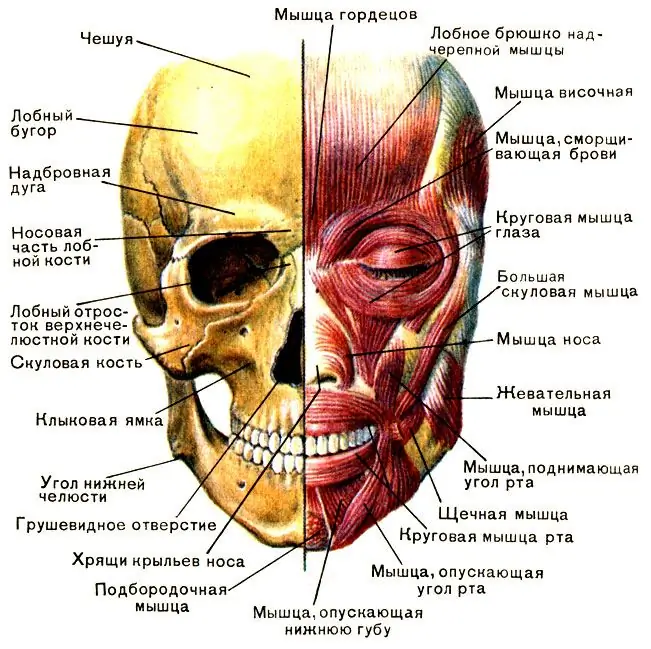
Divided into chewing and mimic. Often, but not always, the muscles of the cranial vault are identified as a separate group. At the same time, despite the division by function, these muscles cannot be considered separately, rather, as elements of a single complex.
- The chewing muscles perform the functions of chewing, speaking and swallowing. They have an attachment (moving point) to the lower jaw and an origin (fixed point) on the bones of the skull. These include the masticatory and temporal muscles, as well as the two pterygoid muscles (medial and lateral).
- Mimic muscles, as the name implies, respondfor the formation of facial expressions. A distinctive feature of facial muscles is that they do not have a double attachment to the bones. Instead, they are attached to the bones only on one side, and on the other, they are woven into the skin, attached to the ligaments, or originate from them. Divided into muscles of the skull, face, nose and eyes.
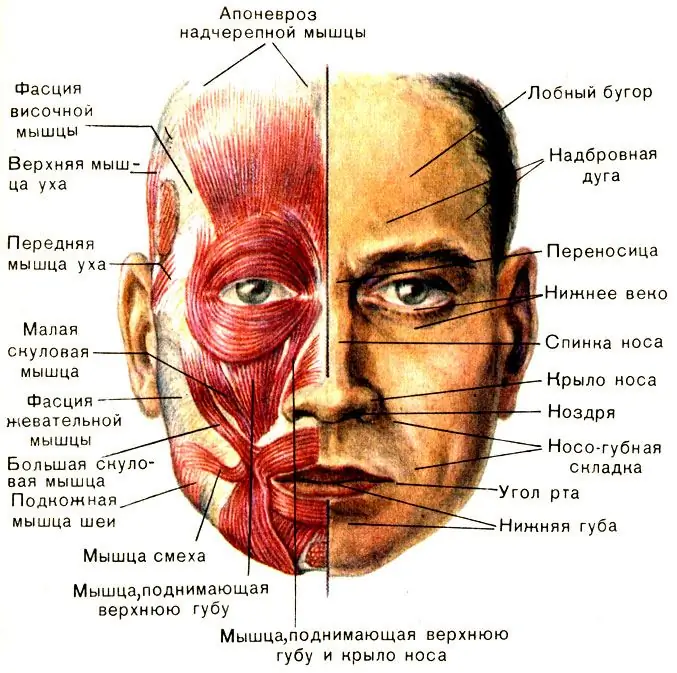
Neck muscles
Can be divided into three groups:
- Superficial muscles. located under the skin. These include the subcutaneous neck (prevents veins from being squeezed by pulling back the skin) and the sternocleidomastoid (holds the head upright and tilts it to its side) muscle.
- Medium. Attached to the hyoid bone. In turn, they are subdivided into muscles located below the hyoid bone and above.
- Deep-lying muscles. Attached to the spine. They are divided into lateral and medial.
The muscles indicated in the picture by the number 1, and partially 2, are often called the muscles-derivatives of the gill arches. This name was given to them because they come from the gill arches of distant human ancestors.
Some of the muscles of group No. 2 and all the muscles of group No. 3 belong to the so-called autochonous muscles. They are remnants of the ventral musculature. Their formation in the form in which they are presented is caused by the reduction of the body cavity and cervical ribs.
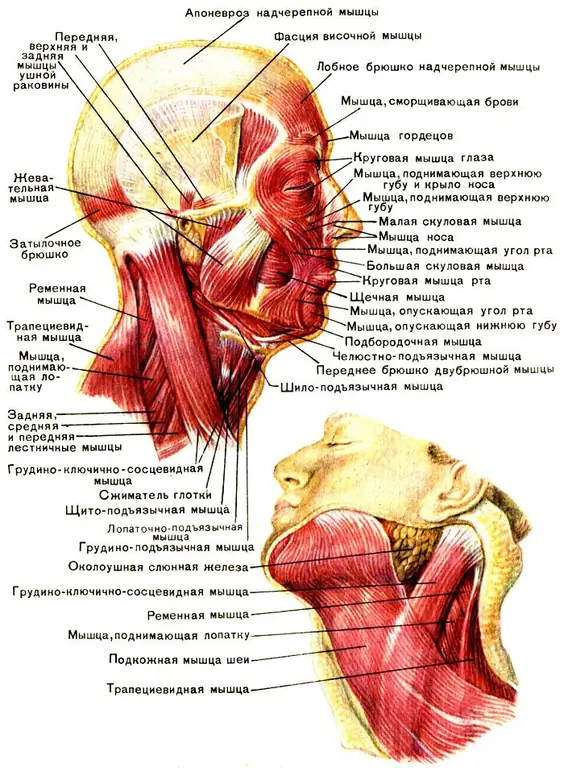
Fascia
Fascia is a sheath of connective tissue that covers any muscle, forming a kind of case for it. fascia functions,as a rule, they consist in creating a support, as well as participating in metabolism.
The structure of the own fascia of the head is heterogeneous. In fact, it is divided into several large parts, called the temporal, chewing and buccal fascia. They got their names based on the muscles they cover.
Cervical fasciae, like the head ones, also have a rather complex structure. The cervical fascia consists of three parts: superficial, pretracheal and prevertebral plates. Each of them has its own structural features and performs a unique role. So, the superficial plate is poorly developed, the prevertebral plate covers only the deep muscles and the spine itself. At the same time, the pretracheal plate is all the other organs and muscles of the neck.

Torso muscles
Formally, they do not refer to either the muscles of the head or the muscles of the neck. Nevertheless, many of the muscles of the trunk are in close interaction with the cervical spine. These muscles are:
- Spleen muscles of the head and neck (also called patch). Provides neck and head movement.
- Spine straightener. She is the longest muscle of the back. Extends the spinal column along its entire length.
- The transverse spinous muscle. Fills the depressions between the transverse and spinous processes of the vertebrae. Breaks down into three layers to form the semispinalis, multifidus, and rotator muscles.
- Suboccipital muscles. Divided into posterior rectus and oblique muscles of the head. Turn their heads.
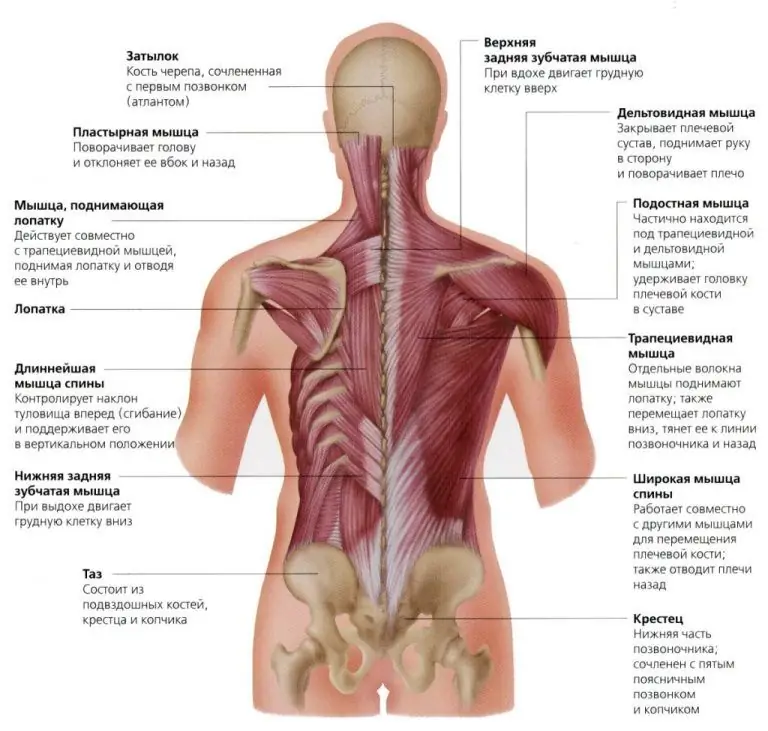
Spasm
Spasm of the head muscles is a common cause of pain. During a spasm, a person's blood vessels are squeezed, which can lead to swelling, pain, and lack of oxygen.
A spasm that caused pain in the muscles of the head can be triggered by many different reasons, you should not immediately grab the first aid kit in search of a cure if it appears. So, sometimes stress, anxiety or depression can act as a catalyst. In addition, the spasm can be caused by being in an uncomfortable position (for example, driving, computer or desk). In this case, it is recommended to simply relieve tension in the muscles of the head, by taking a warm shower or bath, going out into the fresh air and / or simply massaging the back of the head, temples and forehead. If the above measures are ineffective, it is allowed to take an anesthetic.
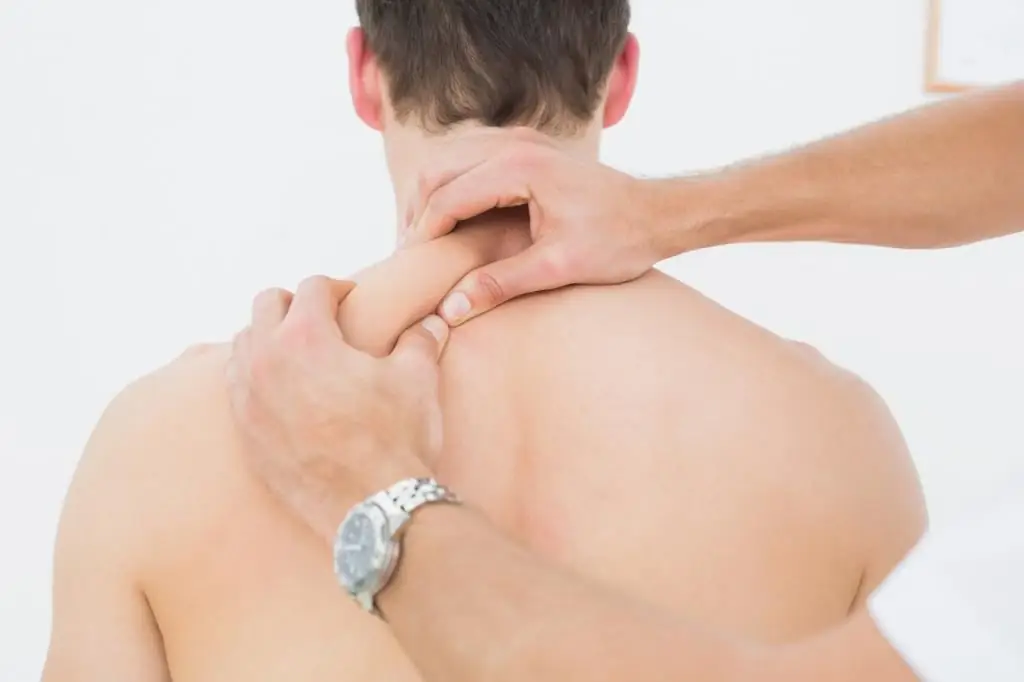
Cervicalgia
Many people over the course of life begin to observe the so-called cervicaglia, which is a sharp ("shooting") pain in the cervical region, which is often accompanied by muscle spasms. During cervicalgia, a person practically loses the ability to move his neck due to pain. Very often, pain is given to the shoulders and upper limbs.
It is known that with the help of cervicalgia, the human body tries to protect itself from possible complications caused by nerve clamping. Muscle spasm is needed to protect the pinched nerve from further impact.
It should be remembered that pain is not a pathology in itself, but issymptoms of other diseases (spondylosis, osteochondrosis, etc.). The best thing to do during a pain attack is to relax, take a comfortable position, possibly take a pain reliever, and wait for relief.
After the onset of relief, it is recommended to slowly start turning your head. The movement should be carried out smoothly, without causing additional pain, in the direction of a more painful and stiff area. If, having reached the extreme point of movement, the contracted muscle responds, this indicates an improvement in its condition. In addition, to normalize the condition, you can take a warm bath and apply self-massage. In case of frequent relapses, you should consult a doctor and be examined for the presence of diseases.
Prevention of spasms
To prevent muscle cramps, you can and should use simple, but extremely effective prevention measures, which include:
- Drinking enough fluids. The likelihood of muscle spasm increases with a lack of moisture. During the day, an adult is recommended to consume 6-8 glasses (1.5-2.5 liters) of boiled water.
- Proper nutrition. Proper nutrition refers to a balanced diet that contains all the necessary nutrients in sufficient quantities. In addition, it is necessary to minimize the consumption of unhe althy foods (soda, fast food, etc.).
- Keeping a he althy lifestyle. This includes giving up bad habits and doing physical exercises, including those described above.
Attention! When formulating a suitable diet andselection of exercises in no case should not rely only on advice from the Internet. The main and last word in this matter should always be with the attending physician!

Cervical muscle training
Weak and atrophied neck muscles perform their functions less efficiently, which leads to an increased risk of spinal diseases. This problem is especially relevant for people recovering from prolonged physical inactivity (due to surgery or other form of therapy).
There are many ways to work out the muscles of the neck. However, a significant part of the exercises require the use of weights, which complicates the technique of their implementation, and also significantly reduces safety. Therefore, the average person has to be content with a small, but quite effective set of isometric exercises. The essence of such exercises is the principle of their implementation, which consists in static muscle tension and overcoming resistance, and not in active movements. Also, the undoubted advantage of these exercises is that, for all their effectiveness, they do not give the effect of a "bull neck".
Exercising
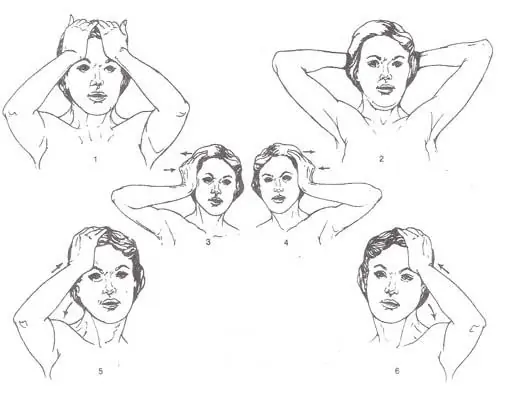
Exercise should begin with a short warm-up, which will prepare the ligaments and warm up the muscles. The warm-up consists in slow tilts of the head in different directions. After the end of the warm-up, you can proceed directly to gymnastics.
Attention! It is better to consult a doctor about the admissibility of performing such gymnastics.
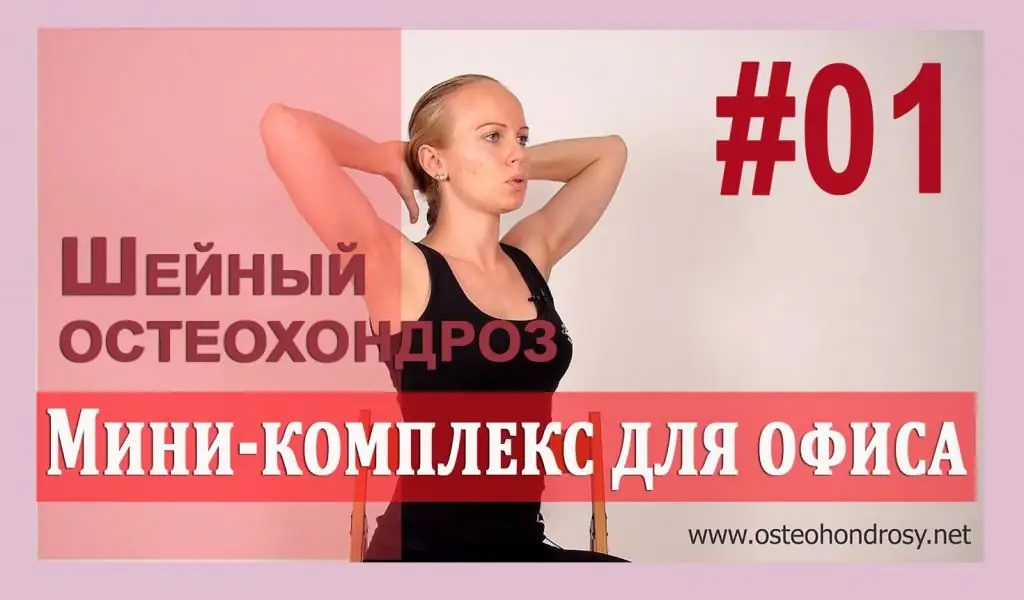
One of the most common mistakes beginners make when doing exercises is also included in the video posted in the text.
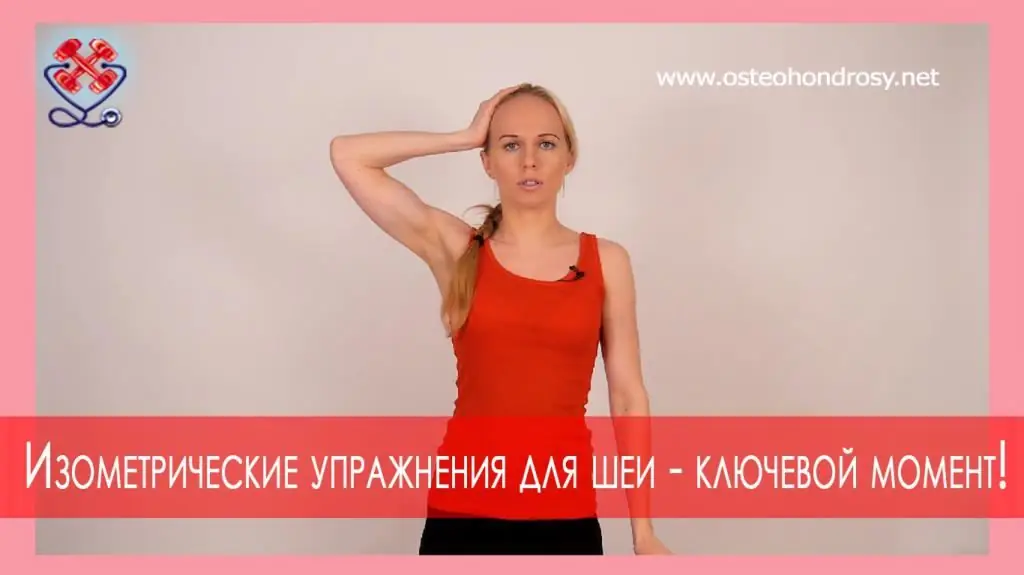
Conclusion
As you can see, the anatomy of the muscles of the head and neck is quite complex. But we can say the following with confidence: the entire muscular system is a single complex that closely interacts with other body systems and thereby ensures its vital activity. Each element of the system is important in its own way, and none is superfluous.






